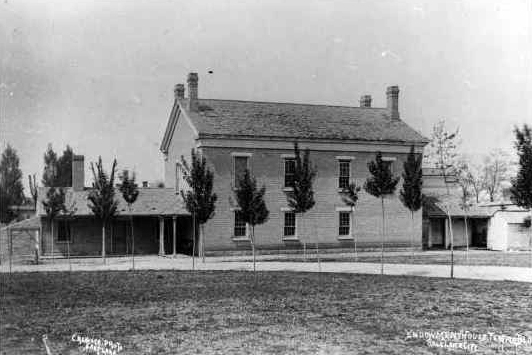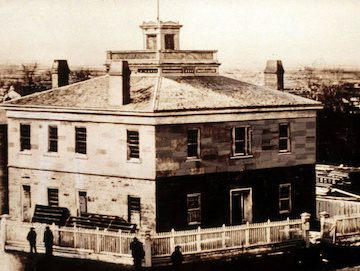Difference between revisions of "Endowment House"
(→Sources) |
|||
| Line 35: | Line 35: | ||
==Sources== | ==Sources== | ||
*[https://www.churchofjesuschrist.org/study/history/topics/endowment-house?lang=eng Church History Topics, “Endowment House”] | *[https://www.churchofjesuschrist.org/study/history/topics/endowment-house?lang=eng Church History Topics, “Endowment House”] | ||
| + | * [https://eom.byu.edu/index.php/Endowment_Houses Encyclopedia of Mormonism, "Endowment Houses"] | ||
| + | |||
[[Category:Temples]][[Category:Church History: Miscellaneous Topics]] | [[Category:Temples]][[Category:Church History: Miscellaneous Topics]] | ||
{{DEFAULTSORT:Endowment House}} | {{DEFAULTSORT:Endowment House}} | ||
Revision as of 17:59, 20 July 2022
While The Church of Jesus Christ of Latter-day Saints performs endowments—as well as other ordinances—for the living and the dead in temples, only endowment ceremonies and sealings for the living were performed in a number of buildings and locations other than temples. These include the Nauvoo Red Brick Store, Ensign Peak (1849), the Council House (1851–1855), and the Endowment House (1855–1889).[1] The Saints were permitted to perform baptisms for the dead and marriage sealings for the dead, but proxy endowments for the dead could not be performed until a temple was completed.[2]
- Between the exodus from Nauvoo in 1846 and the dedication of the St. George Temple in 1877, Latter-day Saints did not have a temple in which to administer baptisms for the dead, endowments, and sealings. Brigham Young did, however, authorize the performance of some temple ordinances outside of temples while the Saints settled the Great Basin and constructed temples in St. George, Logan, Manti, and Salt Lake City. In doing so, he followed a pattern established in a revelation given to Joseph Smith in 1841, which allowed the Saints to perform some temple ordinances outside of temples “in the days of your poverty, wherein ye are not able to build a house unto me.” [Doctrine and Covenants 124:29.] In Nauvoo, Joseph had authorized baptisms for the dead to be performed in nearby rivers for a short period and later administered the first endowments in the upper room of his store.[3]
Contents
The Nauvoo Red Brick Store (1842–1844)
Before the Nauvoo Temple was completed, the large upper room of Joseph Smith's red-brick store building in Nauvoo, Illinois, was used to confer the first temple ordinances on a few leaders of the Church (nine men including Brigham Young)[4] on May 4, 1842, and then on their wives. “These ordinances, called endowments, consisted of a course of instruction and rites that included prayers, washings, anointings, and the making of covenants with the Lord Jesus Christ.”[5]
Ensign Peak (1849)
Addison Pratt missed the opportunity to receive his endowment in Nauvoo because he was serving as a missionary in the South Pacific at the time. In 1849, he was about to leave again on a mission to the Society Islands, or French Polynesia with his family. He and Church leaders wanted him to receive his endowment before he left, and Ensign Peak essentially became a temple for the purpose. On July 21, 1849, Brigham Young, Pratt, and six leaders of the Church gathered there at 6 a.m.[6]
- Young prayed and "consecrated the spot for the present purpose of giving ... Pratt his endowment that we might have power to erect a standard that should be glorified in the eyes of all its beholders, that no unholy thing might come here, that thy servants may come here to offer up prayers and obtain the ministration of angels."
- LDS historian B.H. Roberts wrote that the "action was in harmony with the instructions of the Prophet [LDS Church founder Joseph Smith] in Nauvoo when he said that these ordinances of the temple under certain circumstances might be obtained on the mountaintop, as Moses obtained them."
- Devery S. Anderson, editor of "The Development of LDS Temple Worship," wrote that Pratt's endowment is the only one documented to have occurred on Ensign Peak.[7]
The Council House (1851–1855)
The Council House was constructed in 1849–1850 and was the first public building in Utah. The ground floor housed public events, including banquets, balls, and meetings of the territorial legislature and courts. It was also used as a meeting place for the leaders of the Church of Jesus Christ. The upper floor was used for endowments and sealings until April 1854.
The Endowment House, “Temple Pro Tem” (1855–1889)
Eventually Brigham Young decided that a more secluded space was needed for administering sacred ordinances. In 1854 he directed that a building be constructed on the northwest corner of the temple block in which the Saints could receive the endowment and have their marriages sealed. Completed in April 1855, this modest two-story structure was called the Endowment House. It served, in the words of architect Truman Angell, as a “Temple Pro Tem.”[8]
The main structure was a two-story building 34 feet by 44 feet, with small one-story extensions on both ends. The first floor had a room for washing and anointing, and also "garden," "world," and "terrestrial" rooms. The upper floor was the "celestial room," with an adjacent sealing room.[9]
In 1856 a stone baptismal font was installed and dedicated in an addition on the west side of the building for use in both living and proxy ordinances. Another extension was built later that year to add space for temple workers to prepare for their work and to cook and eat meals.
Between 1855 and 1889, the Saints performed more than 54,000 endowments, 68,000 sealings, and 134,000 baptisms for the dead in the Endowment House.[10]
Although the Salt Lake Temple was not dedicated until 1893, temples in St. George, Logan, and Manti were completed and became available for ordinance work. Although the Endowment House was still used by the Saints living in the Salt Lake area, the need for the Endowment House diminished.
In 1889, however, the solemnizing of plural marriages in the Endowment House became a point of contention in the Church’s legal and political battle with the United States government. Church president Wilford Woodruff decided to demolish the building in October as a demonstration that he was serious about curtailing new plural marriages. In Official Declaration 1, he indicated that one case of plural marriage had been reported, “in which the parties allege that the marriage was performed in the Endowment House, in Salt Lake City, in the Spring of 1889.” President Woodruff continued, “but I have not been able to learn who performed the ceremony; whatever was done in this matter was without my knowledge. In consequence of this alleged occurrence the Endowment House was, by my instructions, taken down without delay.”[11] The Endowment House was dismantled over a few weeks.

